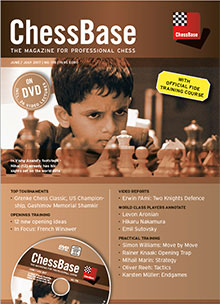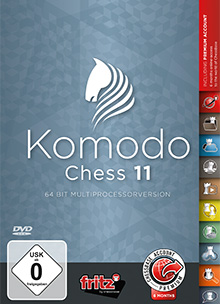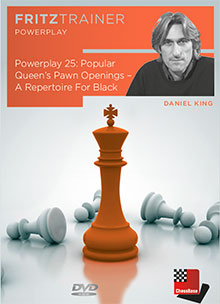


ChessBase 17 - Mega package - Edition 2024
It is the program of choice for anyone who loves the game and wants to know more about it. Start your personal success story with ChessBase and enjoy the game even more.
In Crete, I started fairly slowly but got into a rhythm and was playing fairly well by the end, winning two quite nice endgames against Sergey Ionov of Russia and later on Ram Soffer from Israel.

[Event "World Senior Team Ch., Hersonissos"] [Site "?"] [Date "2017.??.??"] [Round "?"] [White "Soffer, R."] [Black "Speelman, J."] [Result "0-1"] [ECO "D41"] [Annotator "Jon Speelman"] [SetUp "1"] [FEN "6k1/5p2/4p2p/R5p1/3rPn2/5P1P/6PK/4N3 b - - 0 38"] [PlyCount "75"] [EventDate "2017.??.??"] [SourceTitle "Chess 2017 #07"] [SourceDate "2017.06.26"] {Black has a big advantage due to his active pieces, especially the wonderful knight, his space advantage and the weakness of the g2-pawn. Indeed, had I wanted to, I could have cashed in for an extra pawn immediately. ---} 38... Rd1 39. Nc2 {Here I thought, 'What would Kramnik play?' and I was pretty sure that he wouldn't simplify into the rook endgame, but play with rook and knight.} Rd2 ({There was also} 39... Nxg2 40. Kxg2 Rd2+ 41. Kg3 Rxc2 42. h4 gxh4+ 43. Kxh4 Rg2 $1 {, which Soffer saw and I didn't really look for. With the white king cut off it is unpleasant, but I rather doubt that Black is winning.}) 40. Ne3 Re2 41. Ra3 ({I didn't think about} 41. Ng4 {at the time, at least not at all seriously and, indeed, after} Kg7 42. Ne5 Rxg2+ 43. Kh1 Rg3 44. Ra7 Kf6 45. Ng4+ ({or} 45. Nxf7 Rxf3) 45... Kg6 46. Ne5+ Kh5 47. Rxf7 Kh4 48. Rh7 Rxh3+ 49. Kg1 Kg3 {, Black is winning.}) 41... h5 42. Kg1 h4 43. Kf1 Kf8 {Waving my king at him with the generic threat of ...Ke7-d7-c5-b4, which, if Black can achieve it, will obviously be fatal.} 44. e5 $2 {Believing me and making life much easier.} ({Instead, White needed to start harassing the black king, i.e.} 44. Ra8+ Ke7 45. Ra7+ {and here:} Kd8 {- I really didn't like my king being passive and felt that White should have some way to get enough play, though I wasn't particularly sure how. In fact the engines like} ({Unfortunately, the king has to retreat to the back rank, since if} 45... Kd6 46. Nc4+ Kc5 47. Ne5 {it's extremely annoying that} Rxg2 $2 ({during the game I confused myself further by thinking that} 47... Rb2 {was illegal, forgetting that the black knight controls d3, but in any case my pet engine(s) tell me that this is equal: for instance, after} 48. Ra5+ Kd4 49. Nxf7 Rxg2 50. Ra4+ Kc3 51. e5) { gets hit by} 48. Nd3+ {. I certainly didn't like this.}) 46. Nc4 ({or} 46. Ng4 Rxg2 47. Rxf7 Rc2 48. Ne5 Rc1+ 49. Kf2 Rc5 50. Ng4 Nxh3+ 51. Ke3 Rc7 {and perhaps Black can get enough control}) 46... Rxg2 47. Nd6 f6 48. e5 fxe5 (48... f5 49. Ra4 $1 Rg3 50. Nf7+ Kd7 51. Nxg5 {is Houdini's very cunning idea}) 49. Ne4 {.}) 44... Kg7 45. Rb3 ({With} 45. Rc3 Ra2 46. Rc4 Ra1+ 47. Kf2 Nd3+ 48. Ke2 Nxe5 49. Rc5 {, we see that White needs to disturb Black before he can set up ...Nf4 and ...f5, but here the tactics favour Black:} Ra2+ 50. Kf1 f6 51. Rc7+ Kg6 52. Re7 Nd3 $1 {.}) 45... Ra2 46. Rc3 ({If} 46. Rb5 Nd3 {;}) ({or if} 46. Rb4 $2 {(to get to e4)} Ra1+ 47. Kf2 Nd3+ {.}) 46... Ra5 47. Rc2 Rxe5 48. Ng4 Ra5 49. Kf2 f5 50. Ne3 Kf6 {The ideal set-up from which Black can work to improve matters even further. This must surely be lost for White with best play.} 51. Rd2 Ra1 52. Nc4 Nh5 53. Ke3 Rc1 54. Nb2 Nf4 55. Kf2 Ke5 56. Nd1 Kf6 57. Ne3 Rb1 58. Nc4 Nh5 59. Ke3 (59. Rc2 Ng3 60. Nd2 Rd1 61. Nb3 {looks about the best White can do, but I imagine that even if the rooks come off, Black is probably winning 'with best play', as with} Nh1+ (61... Ke5 62. Ra2 Rb1 63. Nd2 {defends for now}) 62. Ke3 Re1+ 63. Re2 Rxe2+ 64. Kxe2 Ke5 {.}) 59... Ng3 $6 60. Kd3 $2 {Over the last few moves, I've 'manoeuvred', hassling White's pieces and trying to find some clean way to do him damage. This ... Nf4-h5-g3 manoeuvre sets up ideas of mate with ...f4 and ...Rf1, but in running away, the white king allows me to cut him off on the e-file, after which it really must be clear. However, even if White resists better than now, looking with the clarity of an engine running, it seems as though he's going to go down, partly because of the threat of ...Nh1+ in many positions followed by...Rg1, sometimes after first checking a king on e3.} ({A sample line:} 60. Rc2 Rd1 { (threatening mate in two!)} 61. Nd2 Re1+ 62. Kf2 Re2+ 63. Kg1 Kg6 64. Rb2 f4 65. Rc2 {and here the engines show that Black has a forced win:} Re1+ 66. Kf2 Rd1 67. Rb2 e5 68. Ra2 Kf5 69. Rc2 Ke6 70. Ra2 Kd5 71. Ra5+ Kd4 72. Ra4+ Kc3 73. Ne4+ Kb3 74. Nc5+ Kc2 75. Rc4+ Kd2 76. Ne4+ Kd3 77. Rc3+ Kd4 {.}) 60... Re1 $1 {Once the king is cut off, it's clearly lost.} 61. Ra2 Nh5 62. Rf2 Nf4+ 63. Kd2 Ra1 64. Ne3 Ke5 65. Nc2 Rb1 66. Na3 Rg1 67. Nc4+ Kd5 $1 {After more manoeuvring, or rather faffing, I realised that I wanted my king on e5 with his on d2 and with me to move, and now arranged this.} 68. Ne3+ Kd4 69. Nc2+ Ke5 70. Ne3 Nd5 {[#]} 71. Nxd5 $2 {This makes it trivial but the knight ending is also pretty easy.} (71. Rf1 Rxf1 72. Nxf1 Kd4 $1 {At the time I was looking at Kf4 but this is much cleaner.} (72... Kf4 73. Ke2 e5 74. Kf2 e4 75. fxe4 fxe4 76. g3+ hxg3+ 77. Nxg3 e3+ 78. Kg2 Nc3 $19 {but I would have been tense playing it.}) 73. Ke2 Kc3 (73... Nf4+ 74. Kf2 Kd3 75. Ne3 Nd5) 74. Kf2 (74. g3 hxg3 75. Nxg3 Nf4+) 74... Kd3 75. Nh2 e5 76. Nf1 (76. f4 Nxf4 77. Nf3 e4) (76. g3 Ne3 77. gxh4 gxh4 78. f4 e4) 76... e4 $1 $19 (76... f4 $2 77. Ke1 (77. Nh2 Ne3 78. Ke1 (78. Kg1 Ke2 79. Ng4 Nxg4 80. hxg4 h3 81. gxh3 e4) 78... Nxg2+ 79. Kf2 Ne3 80. Ke1 Kc3 81. Ke2 Kc2 82. Ke1 Kd3) 77... Ne3 78. Kf2 $1 (78. Nd2 Nxg2+ 79. Kd1 Ke3) 78... Nxf1 (78... Nd1+ 79. Ke1 Kc2 80. Ke2 Nc3+) 79. Kxf1 e4 ) 77. fxe4 fxe4) 71... exd5 (71... Kxd5 72. Re2 ({or} 72. Ke3 Re1+) 72... Kd4 $1 {also wins, of course.}) 72. f4+ gxf4 73. Re2+ Kd4 74. Rf2 ({Alternatively, } 74. Kc2 f3 75. gxf3 Rg3 76. f4 ({or} 76. Re8 Rxf3 77. Kd2 Rxh3) 76... Re3 { and wins.}) 74... f3 $1 75. gxf3 Ra1 0-1
Coincidentally, I had at one moment exactly the same pawn structure and material balance as in a previous game from the 4NCL a few years ago (which arose from a totally different opening, an IQP position arising from a Caro-Kann: 1 e4 c6 2 c4 d5 3 exd5 cxd5 4 cxd5 Nf6 5 Nc3 Nxd5 6 Nf3 Nc6 7 Bb5 e6 8 0-0 Be7 9 d4 0-0 10 Re1 Qd6).

This starting position of the above game arose from a Semi-Tarrasch, 1 d4 Nf6 2 c4 e6 3 Nc3 d5 4 cxd5 Nxd5, a line that Vladimir Kramnik has been playing from time to time with pretty good success. A few days earlier he’d reached a far less promising looking endgame of rook, knight and four against rook, knight and four against Radoslaw Wojtaszek in the first round of the Vugar Gashimov Memorial, and pushed him to the very limit.
Here, briefly, is the Kramnik game:

[Event "Shamkir"] [Site "?"] [Date "2017.??.??"] [Round "?"] [White "Wojtaszek, R."] [Black "Kramnik, V."] [Result "1/2-1/2"] [ECO "D41"] [Annotator "Jon Speelman"] [SetUp "1"] [FEN "6k1/1N3pp1/4pn1p/8/4P3/3r4/5PPP/4R1K1 w - - 0 28"] [PlyCount "111"] [EventDate "2017.??.??"] [SourceTitle "Chess 2017 #07"] [SourceDate "2017.06.26"] {The position in Soffer-Speelman arose from a Semi-Tarrasch, 1 d4 Nf6 2 c4 e6 3 Nc3 d5 4 cxd5 Nxd5, a line that Vladimir Kramnik has been playing from time to time with pretty good success. A few days earlier he'd reached a far less promising looking endgame of rook, knight and four against rook, knight and four against Radoslaw Wojtaszek in the first round of the Vugar Gashimov Memorial, and pushed him to the very limit. Here, briefly, is the Kramnik game. ---} 28. f3 Nh5 29. Nc5 ({Perhaps the way to go was} 29. Re2 Rc3 30. Kf2 Nf4 31. Rd2 g5 32. Nd6 Kg7 33. Nb5 Rc1 34. Nd4 {.}) 29... Rc3 30. Na4 Rc2 31. g3 Nf6 32. Re3 Nd7 33. Rc3 Re2 34. Nc5 Ne5 35. h4 g5 36. hxg5 hxg5 37. Kf1 Ra2 38. f4 Ng4 39. fxg5 Kg7 40. Rd3 Kg6 41. Nb3 Ne5 42. Rc3 Kxg5 43. Rc5 Kf6 44. Nd4 Ra4 45. Nc6 Ng4 (45... Nxc6 46. Rxc6 Rxe4 {is drawn, of course, as the Lomonosov tablebases confirm - but far from fun for White.}) 46. e5+ Kf5 47. Nd8 Kg6 48. Nc6 Ra2 49. Rc3 Kg5 50. Ke1 Ra8 51. Ke2 Ra6 52. Kd2 Rb6 53. Rc4 Rb2+ 54. Ke1 Ne3 55. Rc3 Rb1+ 56. Ke2 Ng4 57. Rf3 Rb2+ 58. Ke1 Rb7 59. Rc3 Rb5 60. Ke2 Rd5 61. Rc4 Nh6 62. Ra4 Rc5 63. Ra6 Kg4 64. Kf2 Rc2+ 65. Ke1 Rc5 66. Kf2 Kh3 67. Kf3 Rc3+ 68. Kf4 Rxg3 69. Nd8 Rg4+ 70. Kf3 Rg3+ 71. Kf4 Rg6 72. Ra7 Rg4+ 73. Kf3 Rg8 74. Rd7 Kh4 75. Ke2 Rf8 76. Rd6 Re8 77. Rd7 Rf8 78. Rd6 Nf5 79. Rd7 Kg4 80. Nxf7 Kf4 81. Ra7 Nd4+ 82. Kd3 Nc6 83. Rc7 1/2-1/2

[Event "4NCL: Barbican-Wood Green HK"] [Site "?"] [Date "2014.??.??"] [Round "?"] [White "Franklin, S."] [Black "Speelman, J."] [Result "0-1"] [ECO "B10"] [Annotator "Jon Speelman"] [SetUp "1"] [FEN "8/8/3Npk2/5pp1/7p/1r1n3P/3R1PPK/8 b - - 0 64"] [PlyCount "13"] [EventDate "2013.??.??"] [SourceTitle "Chess 2017 #07"] [SourceDate "2017.06.26"] {White is in huge trouble here with ...g4 followed by a back rank mate in the air. Sam tried 65 f3, thinking, or perhaps hoping, that he was setting a trap. At first I believed him, but then I realised that Black can have his cake on f3 and successfully digest it. ---} 64... Ne5 65. f3 (65. Re2 g4 $1 {, ignoring the threat of Ne8+, wins easily;}) ({while} 65. Rd1 {makes the best of a bad job, though} g4 66. hxg4 Nxg4+ 67. Kg1 Rb2 68. Rf1 Rc2 69. Nb5 e5 { looks awful.}) 65... Rxf3 $1 66. Re2 Rc3 $1 67. Ne8+ Ke7 (67... Kf7 68. Nd6+ Kf6 $1 {comes to the same thing.}) 68. Rxe5 Rc6 $1 {The point. The white knight is trapped and so Black can defend e6 before eating it.} 69. g4 ({ Instead,} 69. Ng7 Kf6 70. Rxe6+ (70. Nxe6 Kxe5 71. Nxg5 Rc3 $1 {keeps complete control, and if} 72. Nf3+ Rxf3 $1) 70... Rxe6 71. Nxe6 Kxe6 72. Kg1 Ke5 { is a winning pawn endgame:} 73. Kf1 Ke4 74. Ke2 f4 75. Kf2 f3 $1 76. gxf3+ Kf4 {.}) ({As such,} 69. Ra5 Kxe8 70. Ra7 {was the best chance, but if Black is careful, he can certainly win: for example,} Kf8 71. Rh7 Rc3 72. Kg1 Rg3 73. Kf2 f4 74. Ra7 e5 75. Ra4 ({or} 75. Ra2 e4 76. Rb2 e3+ 77. Kf1 f3) 75... Kf7 76. Rc4 Kf6 77. Ra4 Kf5 78. Ra5 g4 79. hxg4+ Rxg4 80. Ra6 Rg3 81. Rh6 h3 { and wins.}) 69... hxg3+ 70. Kxg3 Kxe8 0-1
The above article was reproduced from Chess Magazine July/2017, with kind permission.

CHESS Magazine was established in 1935 by B.H. Wood who ran it for over fifty years. It is published each month by the London Chess Centre and is edited by IM Richard Palliser and Matt Read. The Executive Editor is Malcolm Pein, who organises the London Chess Classic.

CHESS is mailed to subscribers in over 50 countries. You can subscribe from Europe and Asia at a specially discounted rate for first timers here, or from North America here.
 |
ChessBase Magazine 178 CBM came under Sean Marsh’s spotlight just last month and the latest edition features plenty of video and analytical content. Highlights include Levon Aronian presenting his win against Naiditsch from his triumph at Baden-Baden, while in the opening surveys Robert Ris is keen on meeting the Dragon with 6 Be3 Bg7 7 f3 Nc6 8 Qd2 0-0 9 0-0-0 d5 10 Qe1. Order online from |
 |
Komodo Chess 11 The Hamburg software giants nowadays produce the latest Komodo engine, which comes accompanied by the Fritz interface. Mark Lefler and Larry Kaufman’s baby remains well known for its positional understanding – and rightly so: this latest version of Komodo is pretty strong. See the inside back cover for full particulars. Order online from |
 |
Power Play 25: Popular Queen’s Pawn Having written and produced a pair of DVDs for his famous Power Play series on playing the QGD and countering the Catalan as Black, Daniel King now completes his 1 d4 d5 repertoire. As such, viewers get to enjoy both clearly explained and pretty effective counters to the likes of the Colle and London, as well as advice on how to handle the various modern twists White might employ, like Jobava’s 2 Nc3 Nf6 3 Bf4. Order online from |
You can also find these products in the ChessBase Shop